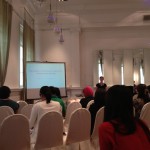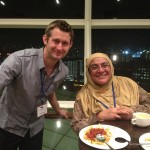Another year, another Asian Festival of Children’s Content in Singapore.
This year’s conference was particularly impressive, with children’s literature scholar and New York Times literary critic Leonard Marcus leading the way with his two fascinating keynote speeches: “Children’s Books: Education vs. Entertainment” and “Imaginations as Big as the World.”
At previous conferences, I’ve tended to focus on presentations that seemed like they would offer advice directly applicable to my career (publication, marketing, writing process, etc.). At this year’s FCC, however, I decided to try out a different approach this year, attending presentations that focused on areas of children’s literature such as illustration and translation that are not directly related to what I write (young adult and middle grade fiction). I can’t pretend there was any great method behind this decision; it was simply motivated by curiosity.
The results were surprising. I actually found that I learned a lot, not only about what people do in different creative fields but also about writing. It was a great reminder that the way we learn best is by comparison, by simile, by analogy.
Below, you can find 2-3 key points I took away from each session, as well as a virtual book shelf of recommended reading compiled during the conference:
1) Leonard Marcus – “Children’s Books: Education vs Entertainment”
- using animal characters in very young children’s books allows children to identify with the character, but also simultaneously feel a sense of superiority (“I’d be smarter than that rabbit…”).
- the “conspiratorial nature” of the relationship between child and children’s author (i.e. need to seem to be “on their side”).
- the central debate: what are children’s books for, to educate or to entertain?
2) Avery Fischer Udagawa – “Translation of Children’s Literature: Pathways to Success”
- to translate fiction into a new target language, you must be able to write fiction in that target language (i.e. it’s really a “whole new book”
- translators (almost always) only work in one direction (e.g. Japanese -> English but not English -> Japanese). This seems obvious now but somehow I’d never fully realized this.
3) Naomi Kojima – “Illustrating for Older Children”
- illustrators pay incredible amounts of attention to the symbolic nature of small visual details. Something as simple as the position of a leg might imply whether a character is brave or timid (or halfway in between, as in Naomi’s example). Again, this seems obvious after hearing it, but is something that writers definitely tend not to do quite so effectively.
- Pencil sharpening = more than once a minute??? Wow.
4) “First Look”/”First Pages” sessions
- First Look – the panel was, for the most part, very impressed. One thing that resonated with me was Leonard Marcus’s comment that sometimes the children in the illustrations were perhaps “smiling too much.” This is something I experienced as a beginning writer: I always had characters laughing and smiling, instead of leaving up to the reader whether something was funny or happy (kind of like a comedic “deadpan” delivery). Also, children need to experience a range of emotions, not just happiness (and no one likes reading about someone who is always way happier than them!).
- First Pages – two things struck me here. One, there were consistent comments about “the stakes not being high enough” in many of the stories presented, i.e. basically a way of saying that there wasn’t enough conflict or intrigue, something I hear constantly about my writing. Two, because all these “first pages” were read aloud, it was painfully obvious which writers had considered the way their language sounded versus those who hadn’t or couldn’t. My number one maxim now when writing and editing is to always, always, always read and re-read one’s work aloud.
5) Leonard Marcus – “Imaginations as Big as the World
- Children, especially younger children, love to see themselves reflected in books. This includes the darker, frightening, more animalistic side of human nature too.
- Great recommendation of picture book writer Mitsumasa Anno (click here to see samples of his work), who took the approach of “teach without teaching” through books on subjects like the roman alphabet, the hiragana syllabary and simple numbers.
I would also like to thank Canadian children’s writer Rukhsana Khan for giving me the confidence and motivation to actually read an excerpt from one of my novels during my presentation “Slick Tricks and Corner Kicks” (instead of just talking about my work), a decision which made a huge difference to my presentation. Nice to have some advice from an experienced writer, presenter and storyteller.


Some Book Recommendations from the conference:
- Brave Story by Miyuki Miyabe
- City of Lies by Lian Tanner
- Dear Genius by Leonard S. Marcus
- うたうしじみ
- 悲しいの王妃
- とび丸龍と案内人
- ドードーの歌








Thank you for this, Trevor! I wasn’t at a couple of these sessions so I really appreciate you sharing some key points. 🙂
Thanks, Tarie! It was a great conference; I was very impressed this year.